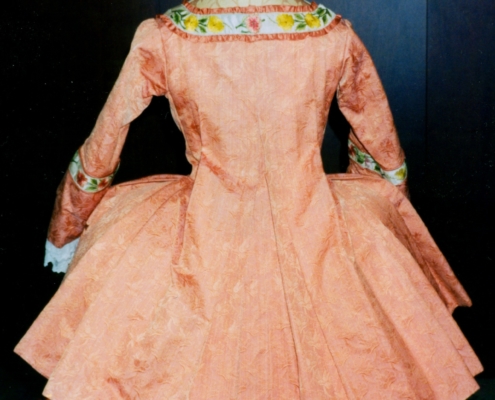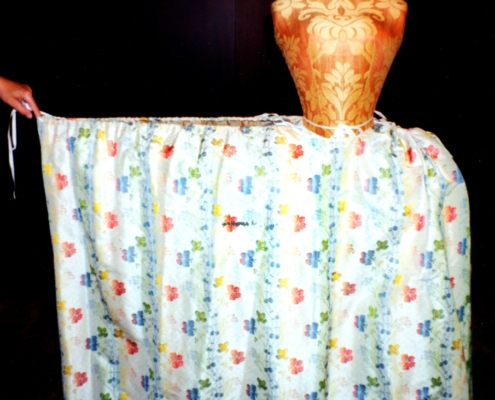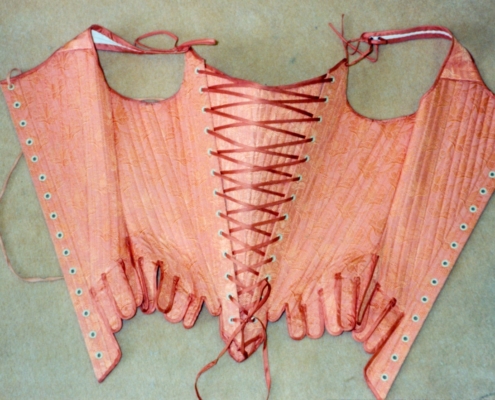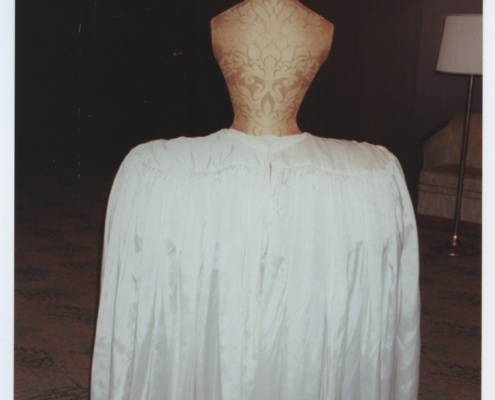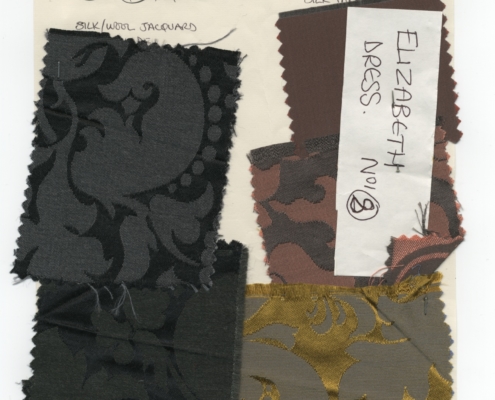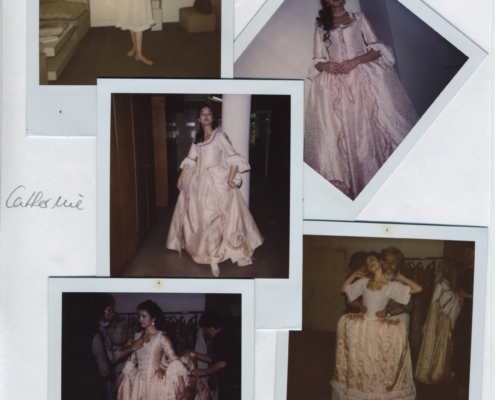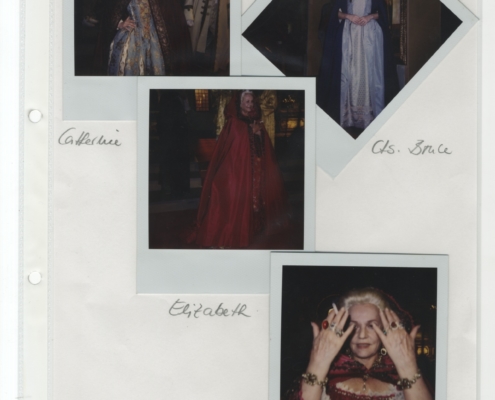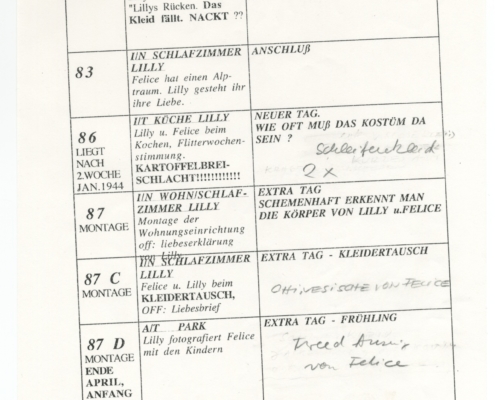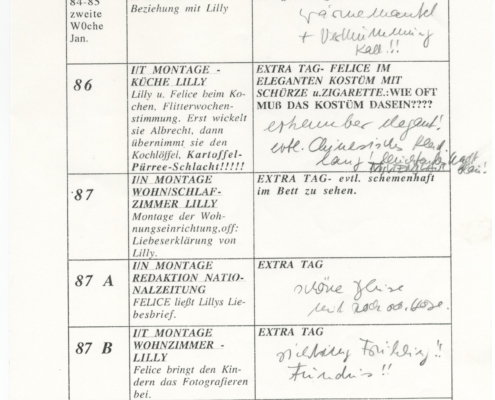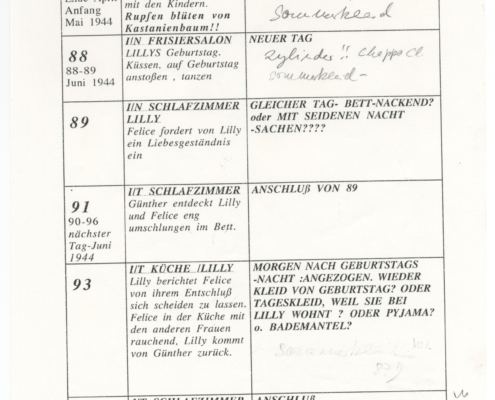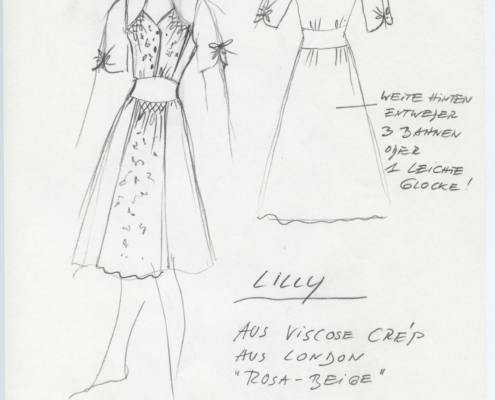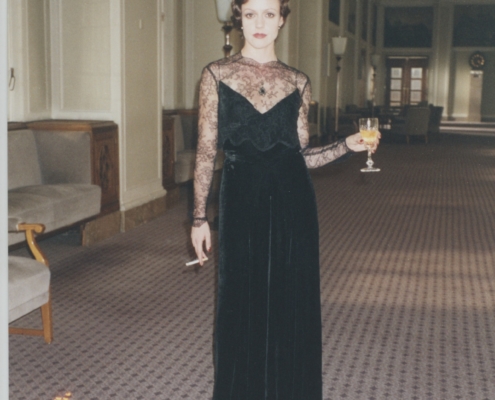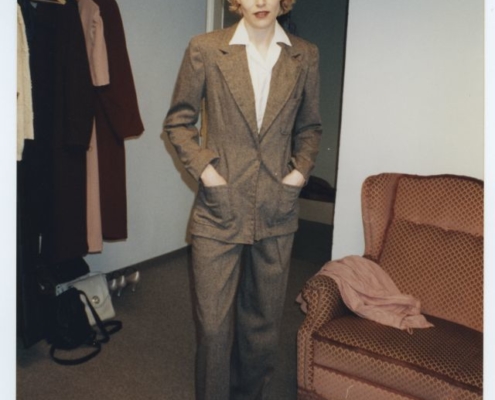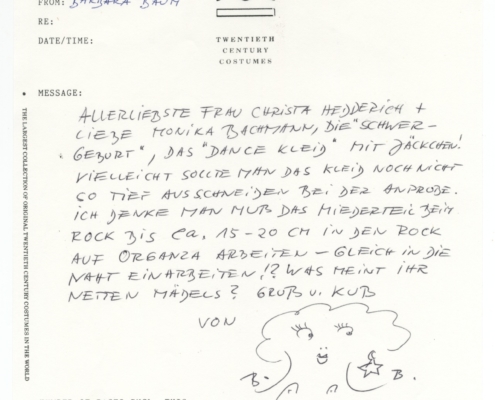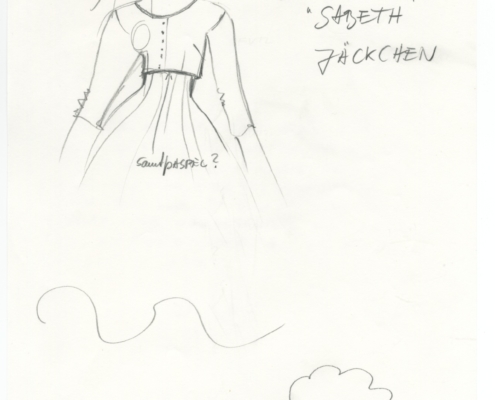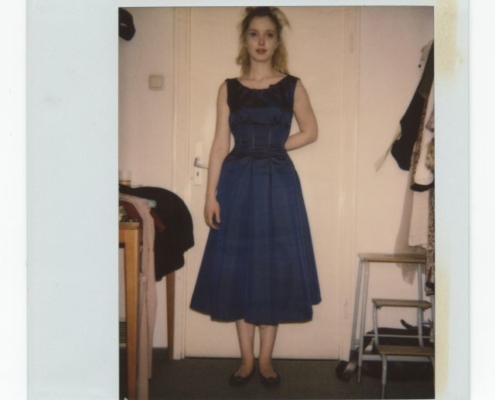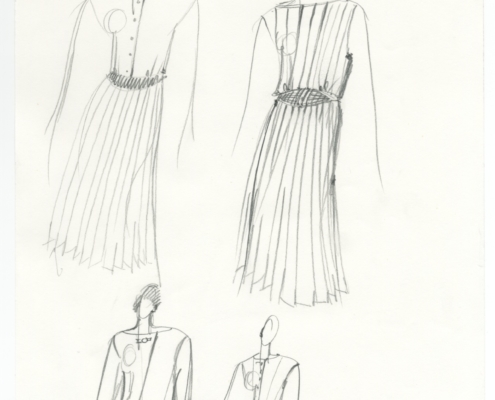This display case contains work material from the movies Catherine the Great, Aimée & Jaguar and Voyager.
The two-part television drama Catherine the Great is about the rise to power of the young Prussian princess Sophie, who became the Russian Tsarina Catherine the Great. Catherine was the breakthrough role for Catherine Zeta-Jones, who was still unknown on the international stage at the time. Supporting roles were filled by Jeanne Moreau and Omar Sharif. The opulent rococo costumes were made in Berlin, Rome and Vienna, and some of the scenes were shot in Studio Babelsberg in Potsdam, by Berlin. A selection of Barbara Baum’s work material for this movie can be found in the left-hand third of this display case. On the left edge are several photographs. One shows a gown of Catherine’s that has a flared, light-colored skirt with a floral pattern, worn over a hooped petticoat. It is paired with a short apricot-colored mantua with a stomacher. The sleeves flare out at the elbow and end in a flounce of white lace. Photographs below show a lace corset on an antique dressmaker’s dummy and close-ups of the floral fabric interwoven with green. To the right of these photos are two handwritten A4 sheets of paper. One is the costume list for Elizabeth, played by Jeanne Moreau; the other is a list of work material required during shooting. The items entered include two ironing boards, two irons, a washer-dryer, and 14 clothes racks. At the center of this part of the display case are fabric samples for Elizabeth’s and Catherine’s costumes. The fabrics for Elizabeth have large patterns in ocher, brown and black; Catherine’s are mainly sheer gray, light yellow and light brown. One of the samples is the silver lamé brocade as used in the wedding gown. On the bottom edge are pages from the working script, featuring Polaroids of the costumes for Elizabeth and Catherine.
To the right of that are three photographs of Catherine Zeta-Jones trying on a glossy apricot-colored rococo gown. In one of them she is wearing a corset, slip and hooped petticoat. Two more photographs show an apricot-colored lace-up corset. In one of the pictures the corset is laid out, in the other it is displayed on an antique dressmaker’s dummy and paired with a white hooped petticoat that flares out at the sides.
Barbara Baum on Catherine the Great and working with Catherine Zeta-Jones
The middle display case is dedicated to Barbara Baum’s work for Aimée & Jaguar. The film is based on the true story of two women who fell in love in Nazi Germany. They were a Jewish woman called Felice (or “Jaguar,” played by Maria Schrader) and Lilly, (or “Aimee,” played by Juliane Köhler), the wife of a Nazi officer. The film was shot in Germany and Poland from April to June of 1997. The movie premiered in competition at the 1999 Berlin International Film Festival. The two main characters each received a “Silver Bear.”
On the top left are two A4 pages taken from a costume plot for the character of Lilly, with some brief handwritten notes. Next to that are two photographs of Juliane Köhler and Maria Schrader during shooting. Lower down is a sheet of paper with a sketch for Lilly’s dress of viscose crêpe. On the left is the front view of the dress, on the right the back view. To the side of and underneath the back view are the following handwritten notes “Full in the back: either three panels or a slight bell!” and “Lilly. Viscose crêpe from London, rose-beige. Needs a patterned fabric insert in the front.”
On the right-hand side are six fabric samples for Lilly’s costumes: two beige samples for a pair of pants; two patterned taupe materials for polo shirts; and two pieces of the same fabric, one blue and one undyed. Next to that is a small strip of white chiffon with a spiral pattern. Underneath the sample are four photographs of the actresses on the film set and in wardrobe. Three are of Juliane Köhler: one in a dress of viscose crêpe; one in a light-colored trench coat; and one in a brown tweed pant suit with a cream-colored blouse. The photograph on the bottom right shows Maria Schrader in a floor-length evening gown made from silky black velvet with a black Chantilly lace over-blouse. In her right hand she holds a cigarette, in her left a glass of sparkling wine. Underneath the photograph is a sample of the black velvet.
The right-hand third of the display case displays work material for Voyager, based on the novel Homo Faber by Max Frisch. The leading roles are played by Sam Shepard, Julie Delpy, and Barbara Sukowa. Shepard’s suits were designed by Armani, while the costumes for Sukowa and Delpy were made at Theaterkunst Berlin. As she often did, Barbara Baum sent the sketches by fax to the costumier with notes and questions on how the ideas should be implemented.
The top right section is dominated by an open black folder, which contains the working script. Four Polaroids have been glued inside, along with detailed handwritten notes on the costumes for Sam Shepard as Walter Faber, Barbara Sukowa as Hanna, and August Zirner as Joachim. To the left are two Polaroids of Shepard. In the top one he is standing in a desert landscape. He is wearing a white sleeveless undershirt with sweat marks in the chest area, gray pants with brown suspenders, and dusty shoes. On his head is a gray hat with a brim. To the left of the file is an A4 page with the design for Barbara Sukowa’s beige pleated dress of wild silk. Underneath, a photo shows the actress being fitted for the dress. Under that photo, to the right, is a lined piece of paper to which six fabric samples have been attached – for the beige pleated dress and the cocktail dress. In the bottom right corner is a Polaroid of Julie Delpy during a fitting for the blue dress. To the right of the fabric samples is Baum’s sketch of the dress. She noted on it by hand: “Rolled pleats in the skirt; nice flare.” This display case finishes with a fax in the bottom right. This was sent by Barbara Baum from London to Christa Hedderich at Theaterkunst Munich: “My ‘difficult birth’ – the cocktail dress with short jacket! Maybe the dress shouldn’t have such a deep neckline for the fitting. I think the bodice of the dress should be worked into the skirt about 15 to 20 centimeters deep, over organza. Perhaps stitch it into the seam? What do you lovely ladies think? Hugs and kisses from…” The fax is signed with a sketch of a woman’s head with wavy hair, two large, alert eyes and a smiling mouth. At the side is a star-shaped earring. This little doodle looks rather like the crown of a tree with a face (Baum means “tree” in German). To the right and left of it, Baum placed her initials.


